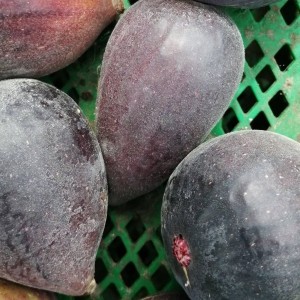Toro Sentado
Toro Sentado Information


-
Possible Synonyms / AKA:
-
Introduced By:
-
Origin:
Spain -
Main Flavor Group:
Exotic - Deep, rich flavor often found in varieties like Black Madeira and Preto, delivering an intense, complex taste that feels luxurious and distinctive. -
Family Group:
-
Fig Type:
Common - Self fertile and will grow anywhere conditions are suitable -
Cold Hardy:
Yes -
Container Variety:
N/A -
Easy Rooting:
Excellent -
Main Season:
early -
Availability:
Difficult -
Breba Crop:
Yes -
Seed Crunch:
mild -
Eye:
small -
Skin Toughness:
moderate -
Fruit Size:
Large -
Rain Resistance:
N/A -
Tree Vigor:
N/A -
External Links:
https://goodfruitguide.co.uk/product/toro-sentado/
https://higosandfigs.com/2019/04/01/higos-frescos-del-peru-disponibles-casi-todo-el-ano/
http://www.fruitnet.com/eurofruit/article/178069/peru-completes-alanar-fig-offering
https://agraria.pe/noticias/por-que-es-cada-vez-mas-dificil-encontrar-11957
http://www.agroambient.gva.es/documents/163228750/167772273/Ensayo+de+formas+de+conducci%C3%B3n+de+la+higuera+en+cultivo+de+alta+densidad/ed1811cc-01f6-43ad-b56f-b2cae43011df
https://higosandfigs.com/2017/12/26/los-higos-negros-peruanos-conquistan-europa/
Description
It seems that the origin of the fig tree is the Mediterranean and its fruits have been much appreciated by the different cultures that have settled on the shores of this sea over the years. But other sources indicate that the fig comes from the countries of the Middle East, covering from the Mediterranean area to western Asia. However, ancient civilizations in the eastern Mediterranean used the fig long before it arrived in Europe.
Probably its cultivation began in southern Arabia from where it extended to other countries. Possibly the Phoenicians were those who spread the cultivation of the fig tree in Cyprus, Sicily, Malta, Corsica, Balearic Islands, Iberian Peninsula, France. The Greeks brought the fruit to Palestine and Asia Minor.
The 'Toro Sentado' variety is native to southeastern Spain where it is grown in the province of Alicante. This variety has been selected by the «Experimental Agricultural Station of Elche» among many other varieties of Black figs of the Valencian Community for intensive commercial cultivation, because although it is not very vigorous it adapts well in intensive crops, apart from its good taste qualities and productivity.
The 'Toro Sentado' brevas are fruits of a very large shape, with an average weight of 63-73 gr, with a Width x Length ratio: 50.86 x 84.27 mm, and a peduncle length of 4, 30 mm They have an elastic epidermis, with medium firmness, good scratching ability, with some thick longitudinal stripe that gives it a visual appeal, with a Black background color and a dark violet color. With a ºBrix (Average of 5 samples) of 16.19 of little sweet flavor, with pale red pulp color, with small or absent internal cavity, with numerous medium achenes. Of good quality in their organoleptic assessment, they are of a beginning of maturation as of May 31. They are resistant to handling and transport.
The 'Toro Sentado' main figs are fruits of a large shape, with an average weight of 47.30 grams, with a Width x Length ratio: 42.48 x 64.36 mm, and a peduncle length of 5 , 00 mm. They have an elastic epidermis, with medium firmness, good scratching ability, with some thick longitudinal stripe that gives it a visual appeal, with a Black background color and a dark violet color. With a ºBrix (Average of 5 samples) of 19.50 of sweet flavor, with pale red pulp color, with small internal cavity, with numerous medium achenes. Of a good quality in their organoleptic assessment, they are of a beginning of maturation from July 31. They are resistant to handling and transport.














